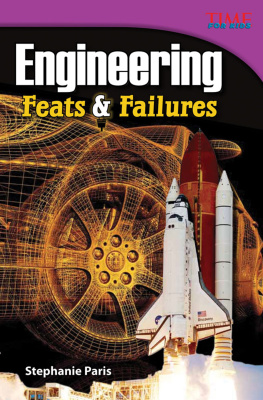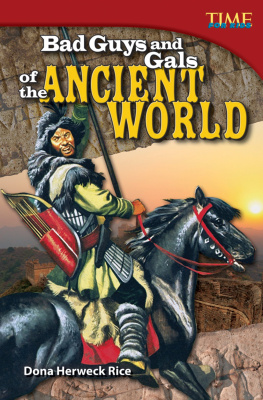
Stephanie Paris
Feats Failures
Technology
Technology
&


Teacher Created Materials
5301 Oceanus Drive
Huntington Beach, CA 92649-1030
http://www.tcmpub.com
ISBN 978-1-4333-4869-3
2013 Teacher Created Materials, Inc.
Consultants
Timothy Rasinski, Ph.D.
Kent State University
Lori Oczkus
Literacy Consultant
Matt Heverly
NASA Engineer
Based on writing from
TIME For Kids. TIME For Kids and the TIME
For Kids logo are registered trademarks of
TIME Inc. Used under license.
Publishing Credits
Dona Herweck Rice , Editor-in-Chief
Lee Aucoin , Creative Director
Jamey Acosta , Senior Editor
Lexa Hoang , Designer
Stephanie Reid , Photo Editor
Rane Anderson , Contributing Author
Rachelle Cracchiolo , M.S.Ed., Publisher
Image Credits:
backcover, p.38 Doug Duncan
[LC-BY-SA-3.0), via Wikimedia; p24 Associated
Press; p.8 The School of Salernum (1922) via
Google Books; p.28 (top) Giraudon/Bridgeman
Art Library; p.18 LOC [LC-DIG-ggbain-04851];
p.20 (top) LOC [LC-USZ62-66023]; p.30 LOC
[LC-G9-Z2-28608-B]; p.12 (top) Hulton Archive/
Getty Images; pp.2021 SSPL via Getty Images;
pp.27 (center), 36 iStockphoto; p.28 (bottom)
AFP/Newscom; pp.17, 22, 27 (right), 40, 41 (top
& bottom) akg-images/Newscom; p.26 akg/
Bildarchiv Steffens/Newscom; p.15 (top) Caters
News Agency Ltd/Newscom; pp.21 (bottom),
40 (top) KPA/United Archives/WHA/Newscom;
p.13 (bottom) MCT/Newscom; pp.20, 41 (middle)
(top) picture-alliance/dpa/Newscom; p.10
(background) Jeff Hageman, M.H.S./Centers
for Disease Control and Prevention; p.15 Volle
Auflsung, via Wikipedia; pp.3233, 37 Janelle
Bell-Martin; All other images from Shutterstock.
Synched Read-Along Version by:
Triangle Interactive LLC
PO Box 573
Prior Lake, MN 55372
ISBN-13: 978-1-68444-935-4 (e-book)

Table
Contents
of
Invention .....................
Health and Survival ............
Productivity .................
Communication ..............
Transportation ...............
Glossary .....................
Index .......................
Bibliography ................. 46
More to Explore ..............
About the Author .............

Invention
New ideas lead to new inventions. Most items
we use each day were invented by humans. Long
ago, someone saw a need for a chair so they made
one. Today, someone may see a way to make a
new app, or perhaps there is an easier way to do
something, like taking a bath. Technology includes
electronics, such as computers or cell phones, but
it also includes things as simple as a wheel or a
needle. In any form, technology is designed to
make our lives easier or more enjoyable.
Most inventions are easy to miss.
They are small changes. If someone
invents a new kind of wheel for
skateboards, who will know? Pro
skateboarders will be thrilled,
and their fans will see
the difference. But most
of the world will never know
anything has changed.
Sometimes, someone invents something that
changes the world. Wha t would life be like without
phones or electricity? But not every invention is a
success. For every new feat , there is at least one
big failure.

How is new technology developed?
Why are failures and mistakes a big
part of success?
How have advances in science,
technology, and engineering
improved our lives?

Health
Survival
and
Video games and books make our lives more
fun. Some inventions, such as paper clips and cars,
make life easier. Other technology improves our
chances of survival. Medical and health advances
make people healthier. They fight diseases and
ease pain. They help people live longer. And the
longer we live, the more time we have to invent
new things!
The invention of the X-ray machine
allowed doctors to see inside our bodies
without cutting into them.
Fascinating Feat

Hazards in the Home
Over million people worldwide suffer from
asthma . Its a condition that can make it hard to
breathe. People with asthma have strong reactions
to mold. But over time, we have perfected the
chemical recipe for cleaning solutions. Someone
invented a cleaning solution that kills mold and
keeps it from growing in our homes.

A Royal Flush
As long as there have been people, there has
been human waste. In ancient times, people
buried it in a hole, but when they moved into
cities, there wasnt room. New technology
was needed.
In 1596, Sir John Harington
invented a toilet that
flushed. It thrilled Queen
Elizabeth I. But it wasnt
until years later that
flush toilets were used
everywhere.
Toilets from before 1990
use more than 3.5 gallons
of water with every flush.
But newer low-flow toilets
use 1.6 gallons of water
with each flush. That saves
over 11,000 gallons of water per
household per year.
The Low-Flow
Sir John Harington

Watch Out Below!
Before we had toilets, people tried many different ways to get
























